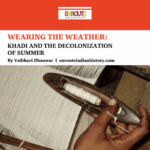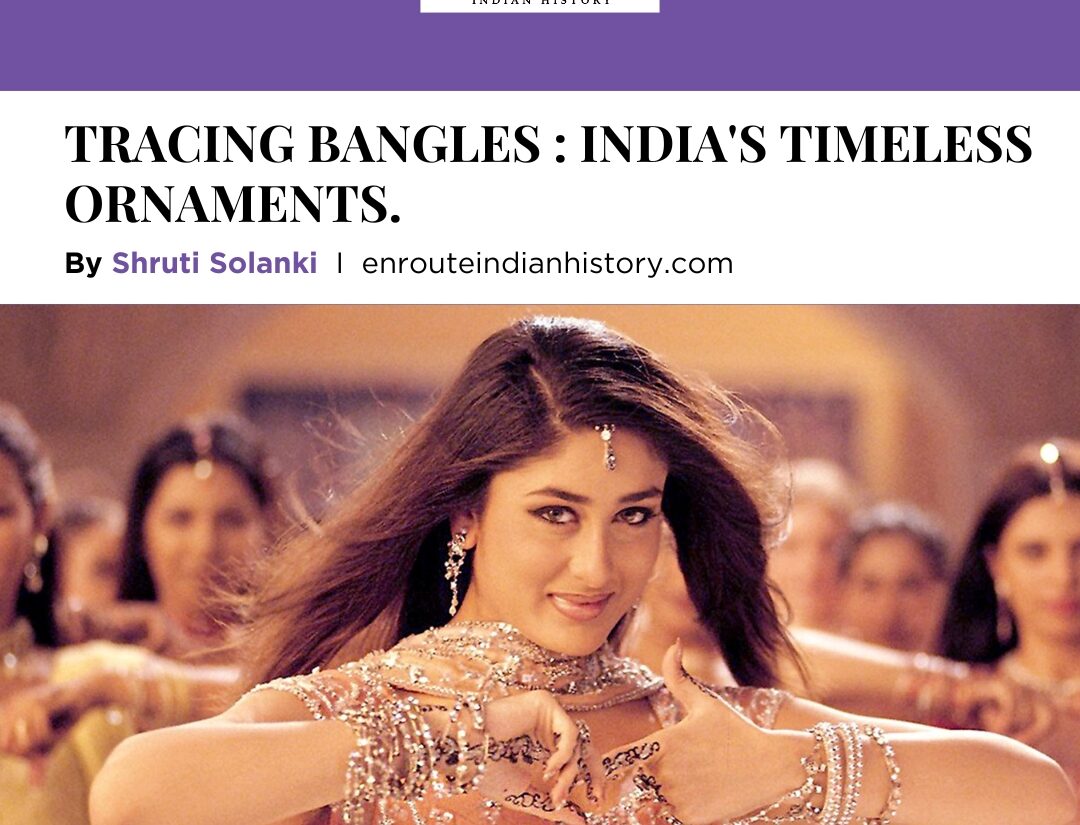
Jewelry is often seen as the most essential part of personal adornment, with bangles, in particular, resonating the most with Indian people. So deeply ingrained in everyday traditions of Indian society are the bangles that their demand is often compared to that of rice, suggesting that they are not just accessories but necessities. Just as rice is a staple in the Indian diet, bangles are considered an indispensable part of attire for many, symbolizing tradition, beauty, and identity and definitely a very diverse culture. Its importance may as well be derived from the fact that the bangle is after all a circle that symbolizes concepts such as totality, eternity, and rebirth, aligning with the South Asian cultural belief in cyclic time, where life and events are seen as part of an ongoing cycle.
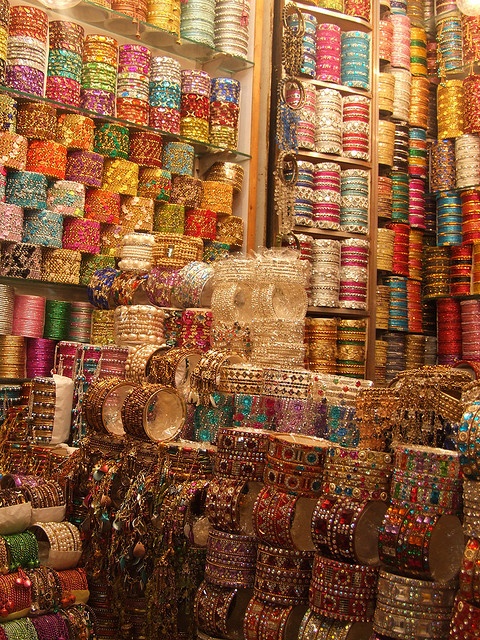
(via https://www.flickr.com/photos/humanityashore/4048246341/in/photostream/)
History of Indian Bangles
Bangles, as we know them today, might have evolved over time, but they have been an integral part of South Asian history, the earliest being dated to the Neolithic period (7000 B.C.E) , recovered at the site of Mehrgarh, presently in Pakistan (Kenoyer, 1991) . Another evidence of their ancient origins dates back to the Indus Valley Civilization, where the celebrated bronze “Dancing Girl” statue from Mohenjodaro (2500-1500 BCE) is adorned with twenty-nine bangles. Additionally, the steatite Siva-Pasupati seal from the same city and era depicts “Siva, the lord of animals” wearing numerous bangles, further emphasizing their historical importance. Excavations from the Indus Valley have uncovered an abundance of bangle fragments, suggesting that various materials such as gold, silver, stoneware, copper, faience, shell, and terracotta were used in bangle-making. This wide variety of materials indicates that bangles were not only ornamental but represented a highly efficient form of visual communication and public identification.
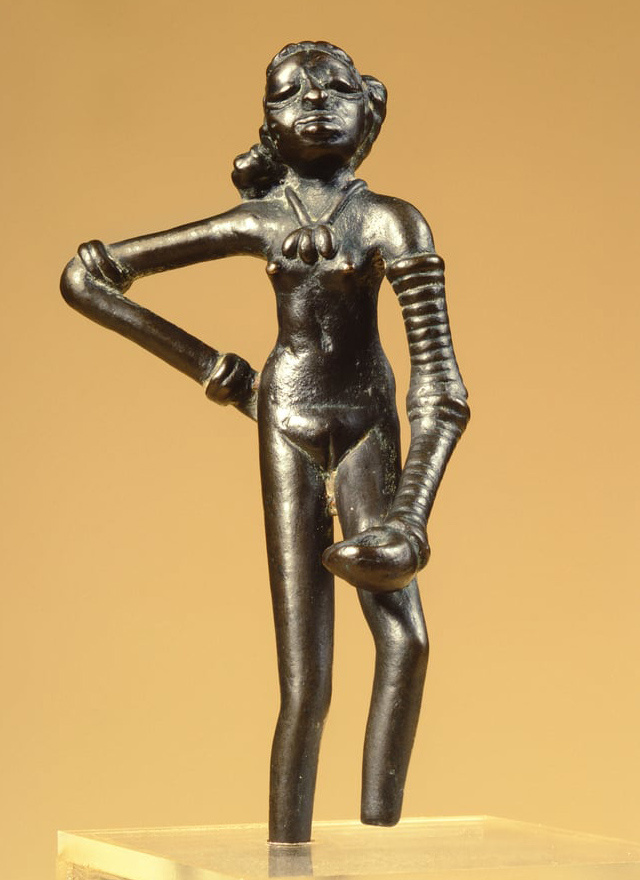
The dancing girl statue adorned with bangles. (via reddit.com)
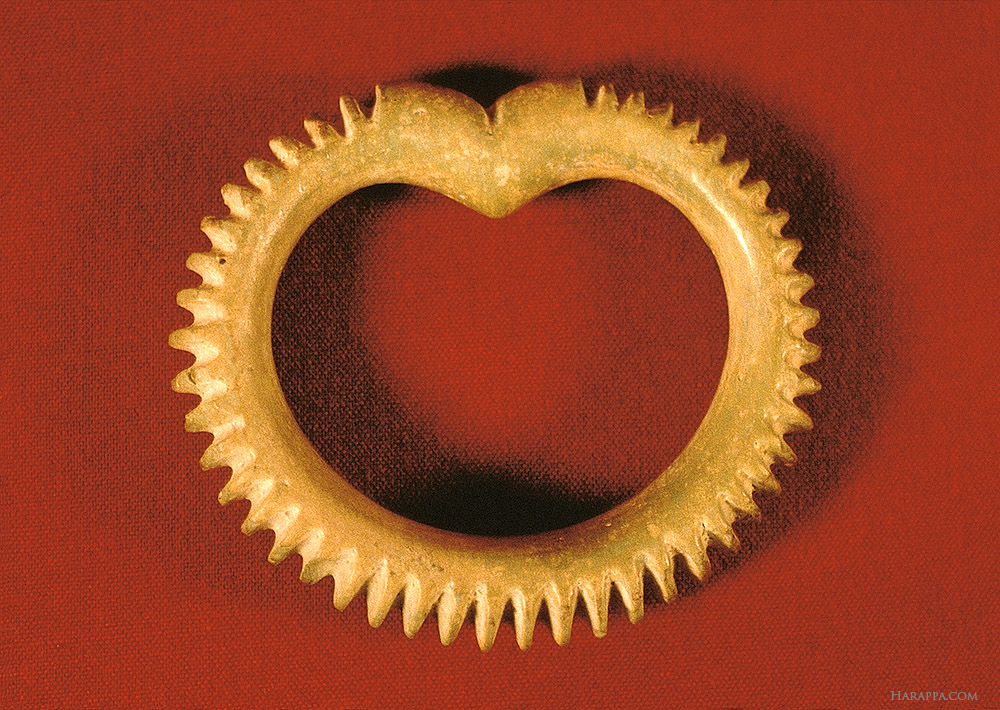
Harappan faience shell bangle (via Harappa.com)
As Indian society underwent immense transitions, the evolution of bangles mirrored these changes both in form and symbolism. Buddhist cave paintings at Ajanta, dating back to the 2nd century BCE, depict figures adorned with bangles, and decorated with various jewelry pieces, including the singhār pattī or on the forehead, intricate necklaces and bazūbands worn on the upper arms emphasizing their ornamental allure.
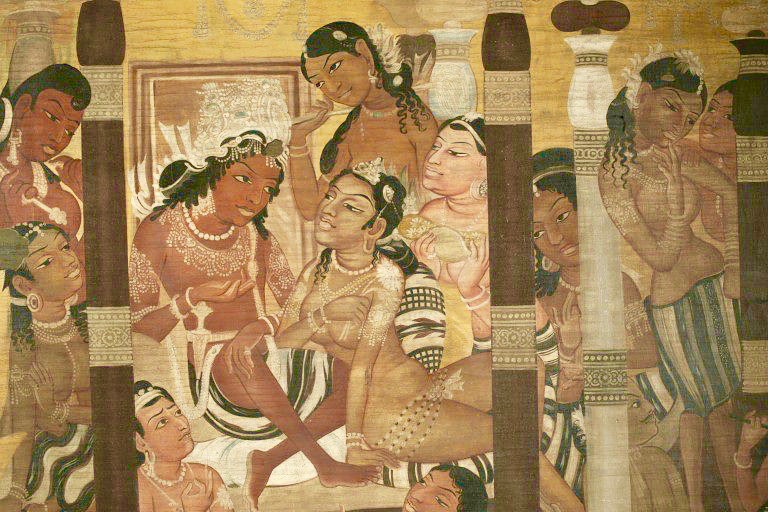
(Ajanta cave painting via Wikimedia commons)
This continuing tradition of bangle adornments, seen in the ancient frescoes, illustrates how bangles have been integral to Indian culture. During the medieval period, the arrival of new dynasties, such as the Mughals, introduced a blend of artistic influences that enriched bangle craftsmanship. The Mughals were particularly instrumental in elevating the art of bangle-making, with intricate designs and elaborate motifs that reflected the opulence of their time.
Indian Bangles
The history of Meenakari jewelry, for instance, is a fascinating journey that dates back to the Mughal era around the 16th century. Over time, this exquisite art transcended royal circles in the form of bangles and became integral to India’s cultural identity. Gold and silver bangles of the period were adorned with precious gems, intricate engravings, and vibrant enameling, transforming them into exquisite works of art that signified status and prosperity. The medieval period also witnessed the rise of regional styles, with distinct bangle-making traditions emerging across India. The lac bangles of Rajasthan and the glass bangles of Firozabad are prime examples of this diversity, each reflecting the unique cultural medley of its region. Meenakari was often combined with Kundan—the inlay of stones in gold—creating stunning pieces worn by emperors in numerous styles to adorn themselves. Indian history has seen the rule of many dynasties each adding their own traditions to the land and incorporating their lifestyles into the society.
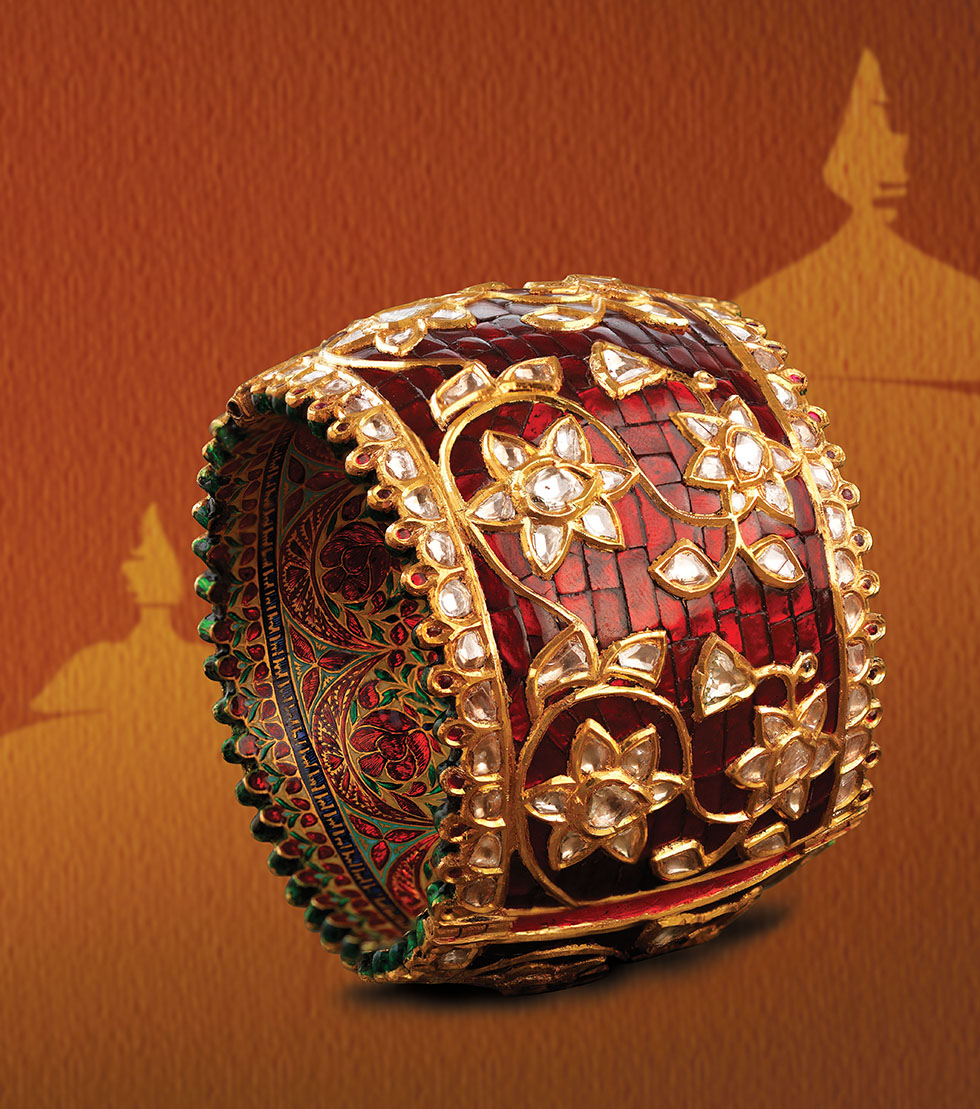
(Mughal style meenakari bangle via https://www.katerinaperez.com/articles/indian-glamour-discover-mughal-jewellery-style-and-jewellery-making-techniques)
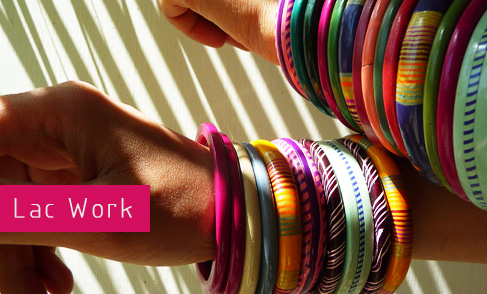
Lac bangles via https://gaatha.com/maniharon-ka-raasta/)
Regional Indian Bangle Traditions and Craftsmanship
Materials Used in Indian Bangles are varied, each with its unique significance and appeal. Glass bangles, for example, hold a prominent place in Hindu social life. They are known for their vibrant colors and affordability, with Firozabad in Uttar Pradesh being renowned for its glass bangle industry. Metal bangles, such as those made from gold, are highly valued and often given as gifts during weddings, while silver bangles are popular in Gujarat and Rajasthan. Lac bangles are made from a natural resin and are known for their rich colors and artistic designs, incorporating mirror work, beads, and stones. Additionally, bangles made from wood and clay are popular in regions like West Bengal and Odisha, where artisans carve and paint intricate designs. The Kundan and Meenakari work has also flowed from being the Traditional Indian Bangle Designs from the medieval periods to the contemporary era without losing its charm. Filigree and engraving are also common techniques, with filigree creating delicate patterns using thin wires of gold or silver, and engraving adding depth to metal bangles with floral or geometric motifs.
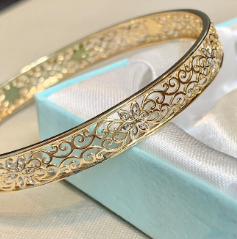
(Filigree design bangle via https://jewelofthebay.com.au/products/9ct-2-tone-gold-filigree-bangle-g7508 )
Symbolism of Bangles in India
The timeless evolution of bangles in India spans from ancient epics like the Mahābhārata to modern times, reflecting a mosaic of cultural and symbolic meanings. In the epic, the sankha valaya (shell bangle) worn by the character Brihannala is seen as a sign of femininity, illustrating how bangles have long been associated with womanhood. A gendered meaning has persisted through various historical periods, such as the medieval era, when a Rajput was presented with a pair of bangles as a mark of cowardice for failing in battle. This tradition of bangles as emblems of gender identity and societal roles continued into modern times, notably during the Civil Disobedience Movement, where the “Bangle League” was organized specifically to enact and perform the north Indian taunt “churiyaan pahan lo” (you should wear bangles) implying that the non-resisting Indian males were weak or failing to uphold their responsibilities as men. The taunt reflects a deeply rooted patriarchal mindset that equates femininity with frailty and passivity while positioning masculinity as synonymous with strength and competence.
Our understanding of the gendered meaning and cultural significance of Indian bangles remains incomplete without referencing Sarojini Naidu’s famous poem “The Bangle Sellers,” which beautifully captures the cultural essence of bangles in a woman’s life:
“Bangle sellers are we who bear
Our shining loads to the temple fair…
Who will buy these delicate, bright
Rainbow-tinted circles of light?
Lustrous tokens of radiant lives,
For happy daughters and happy wives.”
Naidu’s poem reflects the vital role bangles play in a female’s life, symbolizing joy, beauty, and significant life events. In Indian culture, bangles, particularly the “chooda” (a set of traditional red and white bangles), are considered an integral part of the “solah singar” (sixteen adornments) of a bride, completing her wedding ensemble. Glass bangles are especially revered in Hinduism, where they are seen as symbols of marriage, known locally as “churi pehnan”. They hold similar significance to “sindoor”, “nath”, and “mangalsutra”, serving as visible indicators of a woman’s married status.

(Pinterest.com)
Throughout India, bangles are deeply ingrained in regional customs and traditions, each type carrying unique cultural and symbolic meanings. For instance, Bengali women are traditionally associated with iron and conch shell bangles, which are believed to symbolize strength and protection. Rajput women, on the other hand, often wear ivory bangles, which represent purity and grace, while Gujarati women favor a combination of ivory, coconut, and silver bangles, reflecting their cultural heritage and social status. However, beyond their cultural significance, bangles have also become synonymous with frailty, a trope that perpetuates patriarchal notions of femininity and weakness. While they are celebrated for their beauty and cultural significance, their use as instruments of shame and gender-based critique reveals the patriarchal forms in which societal values and norms are perpetuated through everyday objects and traditions.
Contemporary Visualisations
Despite of the dual symbolism present in the bangles, it has retained an omnipresent positive feminine character in popular perception. From appearing in Pakeezah’s ethereal dance sequences, where Meena Kumari’s graceful movements accentuated the poetic allure and tragedy of her character, to adorning Gangubai Kathiawadi’s hands as symbols of resilience and empowerment in Alia Bhatt’s portrayal, bangles have elevated from their decorative purpose towards becoming powerful narrative devices. In classic films like “Mother India” (1957), bangles represent the struggles and sacrifices of Nargis’s character, Radha, symbolizing strength and the indomitable spirit of motherhood. Fast forward to “Kabhi Khushi Kabhie Gham” (2001), where bangles on Kareena and Kajol’s character subtly popularized the ornament in popular culture, or “Padmaavat” (2018), in which Deepika Padukone’s Rani Padmavati uses bangles as expressions of royalty and resistance. Through these films, bangles have become a timeless emblem, influencing contemporary indian bangle trends bridging the gap between tradition and modernity.
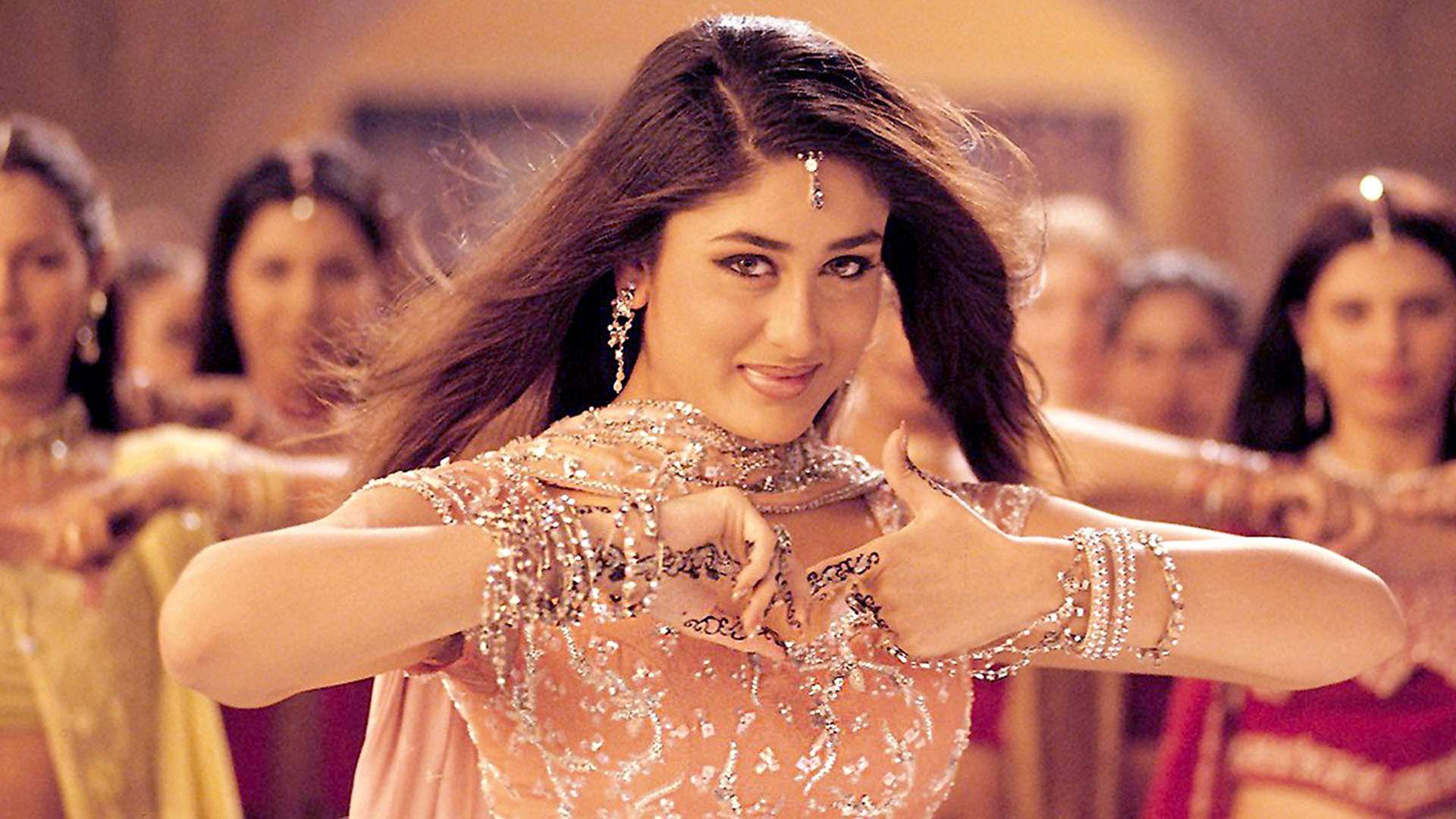
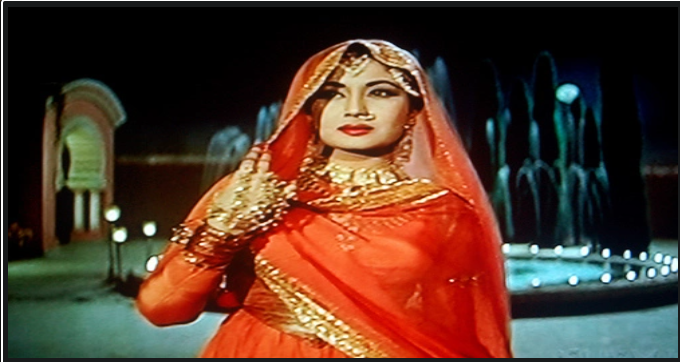
Bangles have long been a cornerstone of ornamental diversity in South Asia, spanning from ancient to contemporary times. They celebrate beauty and tradition while also reflecting and challenging evolving perceptions of femininity and strength. From their shimmering colors and intricate designs to their musical tinkle and traditional value, bangles have withstood the test of time. They have been an integral part of female life, encompassing various roles and meanings across different cultures. So, the next time you see elegant arms adorned with strikingly beautiful bangles resting delicately on their wrists, take a moment to appreciate their significance. You might just find yourself inspired by the timeless charm and cultural depth that the bangles represent.
References –
Ali, Mariam, and Masooma Abbas. “Jewellery of the Indian Subcontinent: A Significant Cultural Element.” Journal of Development and Social Sciences 3.2 (2022): 901-915.
Zulfiqar, Anila. “Exploring the Symbolic Representation of the Social, Religious and Ritualistic Aspects of South Asia through Glass Bangles.” Pakistan Social Sciences Review 6.2 (2022): 1048-1058.
Sankalia, H. D. “The antiquity of glass bangles in India.” Bulletin of the Deccan College Research Institute 8 (1947): 252-259.
Kanungo, Alok Kumar. “Glass bangles in India: Antiquity, functional use and traditional production.” South Asian Studies 38.1 (2022): 19-39.
Basner, Kelly. “A Glittering Arsenal: Bangles, Duty and Transgression in North India.” (2010).
https://budhagirl.in/blogs/budhabrief/the-history-of-the-bangle
https://johori.com/blogs/news/the-history-behind-meenakari-jewellery
- Contemporary Indian Bangle Trends
- Craftsmanship of Indian Bangles
- Cultural Significance of Indian Bangles
- History of Indian Bangles
- Indian Bangle Craftsmanship Techniques
- Indian Bangle Traditions
- Materials Used in Indian Bangles
- Modern Bangles in Indian Fashion
- Symbolism of Bangles in India
- Traditional Indian Bangle Designs
